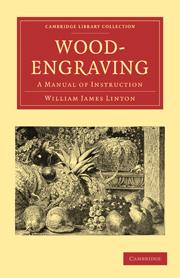Book contents
- Frontmatter
- PREFACE
- Contents
- ILLUSTRATIONS
- CHAPTER I Of engraving in relief
- CHAPTER II Of the history of Wood-Engraving
- CHAPTER III Of the difference between cutting and engraving
- CHAPTER IV Of the tools required for engraving on wood
- CHAPTER V Of drawing on wood for engraving
- CHAPTER VI Of the method of procedure in engraving
- CHAPTER VII Of things to be avoided
- CHAPTER VIII Of things to be aimed at
- CHAPTER IX Of beauty of line
- CHAPTER X Of the use and abuse of photography
- CHAPTER XI Of what constitutes an Artist
- CHAPTER XII of works for reference
- Index
- Plate section
CHAPTER I - Of engraving in relief
Published online by Cambridge University Press: 29 August 2010
- Frontmatter
- PREFACE
- Contents
- ILLUSTRATIONS
- CHAPTER I Of engraving in relief
- CHAPTER II Of the history of Wood-Engraving
- CHAPTER III Of the difference between cutting and engraving
- CHAPTER IV Of the tools required for engraving on wood
- CHAPTER V Of drawing on wood for engraving
- CHAPTER VI Of the method of procedure in engraving
- CHAPTER VII Of things to be avoided
- CHAPTER VIII Of things to be aimed at
- CHAPTER IX Of beauty of line
- CHAPTER X Of the use and abuse of photography
- CHAPTER XI Of what constitutes an Artist
- CHAPTER XII of works for reference
- Index
- Plate section
Summary
TO ENGRAVE, says Johnson, is to picture by incisions. The root of the word, writes Chatto, is to be found in the Greek γράφω (grapho), I cut: upon which he observes:—“From the circumstances of laws, in the early ages of Grecian history, being cut or engraved on wood, the word grapho came to be used in the sense of ‘I sanction or pass a law;’ and when, in the progress of society and the improvement of Art, letters, instead of being cut on wood, were indented by means of a skewer-shaped instrument (a ‘stylus’) on wax spread on tablets of wood or ivory, or written by means of a pen or reed on papyrus or on parchment, the word grapho, which in its primitive meaning signified to cut, became expressive of writing generally. From grapho is derived the Latin scribo, I write; and it is worthy of observation that to scrive (probably from scribo) signifies in our own language to cut numerals or other characters on timber with a tool called a scrive: the word thus passing, as ifc were, through a circle of various meanings, and in different languages, and at last returning to the original signification.” [Treatise on Wood-Engraving, by Jackson and Chatto, 1838.]
Mr. Chatto's explanation will become clearer if, instead of cut on wood, &c, we say cut in wood, in wax, in timber: bearing in mind Johnson's definition—to picture by incisions;—to engrave (in French, graver) being really to grave, to cut a trench or a furrow, as with a spade or a plough, the cuts or incisions giving the lines of the writing or picture.
- Type
- Chapter
- Information
- Wood-EngravingA Manual of Instruction, pp. 1 - 6Publisher: Cambridge University PressPrint publication year: 2010First published in: 1884

